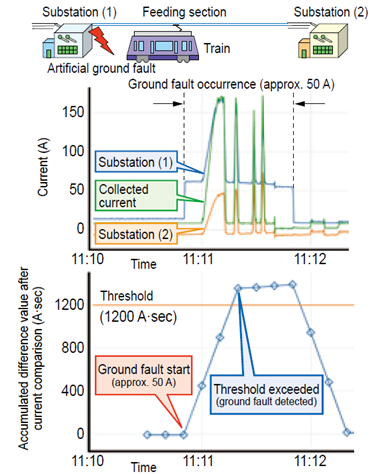6. Detection System for DC High-resistance Ground Faults by Utilizing the Current Data of Both Substations and Vehicles
One of the challenges in monitoring the integrity of overhead contact line equipment in DC traction system is the difficulty in detecting high-resistance ground faults, in which current leaks to the ground through supports of contact line or other paths due to causes such as flying debris. A well-known detection method is adding protective discharge gaps or similar voltage-limiting devices to the contact line system, however, this faces challenges such as the need for maintenance of additional devices. In contrast, methods based on monitoring feeder current only at substations have detection difficulty on small fault current with about hundreds of amperes, which is much less than current consumed by trains in normal operation. To address this, we developed a system that detects high-resistance ground faults utilizing the current data of both substations and vehicles and comparing the difference of the total feeding currents from substations with the total traction loads (collected current of all trains), taking the position of trains within the feeding sections into account (Figure 1).
In this system, measurement devices installed at substations and on trains continuously transmit current data with high-precision timestamps of every sample point, along with train position coordinates and other relevant information, to a data server. Next, the system links coordinate of train to the relevant feeding section. For each section, the system calculates the total feeding currents and the total traction loads present in the relevant section. It then compares the current between the substations and the trains, and when the accumulated value of the current difference exceeds a predefined threshold, a high-resistance ground fault is determined.
We built a prototype system as a module utilizing data integration and kilometrage conversion functions from the previously
developed integrated analytics platform for railways. Verification tests conducted on the test track at the Institute confirmed that the system can detect ground faults of approximately 50 amperes under a traction load of about 160 amperes (Figure 2). In future, by applying high-precision current sensors, the system can detect ground faults of several hundred amperes even on commercial lines where traction loads reach several thousand amperes.
Based on the verification results, we compiled the basic specifications and design guidelines for implementing this method in substations and trains. This method can be implemented in environments where train position and current data can be collected and can be transmitted to a data server.
Other Contents
- 1. Performance Evaluation Method for Earthquake Early Warning Systems
- 2. Method for Setting Regulation Values for Operation Control Under Rainfall Using Radar Rain Gauges
- 3. Method for Estimating Track Buckling Risk Based on On-board Measurements
- 4. Method for Identifying Wheel Usage Limit Temperature and Evaluating Safety While in Service
- 5. Investigation of Front Rod Fracture Causes and Maintenance Methods to Prevent Fracture
- 6. Detection System for DC High-resistance Ground Faults by Utilizing the Current Data of Both Substations and Vehicles
- 7. Forward Obstacle Detection System for Trains in Preparation for Future Driverless Operation
- 8. Validation of the Long-term Effectiveness of Automatic Deerdeterrent Sound Devices
- 1. Performance Evaluation Method for Earthquake Early Warning Systems
- 2. Method for Setting Regulation Values for Operation Control Under Rainfall Using Radar Rain Gauges
- 3. Method for Estimating Track Buckling Risk Based on On-board Measurements
- 4. Method for Identifying Wheel Usage Limit Temperature and Evaluating Safety While in Service
- 5. Investigation of Front Rod Fracture Causes and Maintenance Methods to Prevent Fracture
- 6. Detection System for DC High-resistance Ground Faults by Utilizing the Current Data of Both Substations and Vehicles
- 7. Forward Obstacle Detection System for Trains in Preparation for Future Driverless Operation
- 8. Validation of the Long-term Effectiveness of Automatic Deerdeterrent Sound Devices


